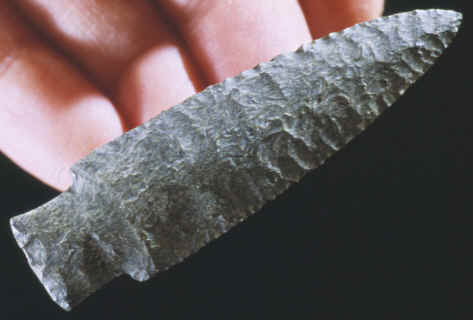|
SCOTTSBLUFF
This Scottsbluff Type I
point was found on the Finley bison kill site in Sweetwater County near
Eden, Wyoming sometime in the 1940's. It's a spear point that dates to the
Paleo-Indian period and it was probably propelled through the air with a
throwing stick (atlatl). This point was classified by H. M. Wormington as
a Type I Scottsbluff point. It's made of an opaque dark colored chert and
measures 2 13/16 inches (7.1 cm) long. THE FINLEY BISON
KILL SITE
The Finley site is a Paleo-Indian bison kill site. It was discovered in
1939 by O.M. Finley. Various excavations of the site in the 1940's
produced 24 projectile points. Six were classified as Scottsbluff points,
and eight as Eden points. One complete Cody knife was also found. SCOTTSBLUFF POINTS
Scottsbluff points were named by C.B. Schultz and E.H. Barbour in 1932 for
points of this style found with bones of extinct bison near Scottsbluff,
Nebraska. Scottsbluff points have a wide distribution area. They are found
in west central Canada and the Rocky mountains as far northeastward as
Wisconsin and as far south as northwestern Louisiana, southwestern
Arkansas, Texas and Oklahoma. |
|
"REFERENCES"
1957,
Wormington, H.M., "Ancient Man In North America", pp.124-127. |
